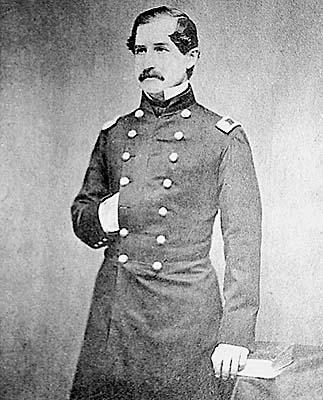When Marion Isabelle Twiggs, the daughter of United States Army General David E. Twiggs, the commander of the United States forces in Texas, first met one of his staff officers, Colonel Abraham C. Myers, she immediately fell in love, sparking a romance that would leave a legacy in the naming of Fort Myers, Florida. Shortly after, because of ongoing conflicts with the Seminole Indians in Florida, her father and Myers were moved to Florida. Twiggs was responsible for leading the troops at Fort Brooke, now known as Tampa Bay, Florida, while Myers became the chief quartermaster. While at Fort Brooke, Abraham, and Marion continued their romance and became engaged. Twiggs supported their engagement, even though Myers was 39 and his daughter was only 13.
On February 14th, 1850, the War Department instructed Twiggs to build a fort on the Caloosahatchee River again. He named the fort Fort Myers “to show respect for his future son-in-law and make his daughter happy.”

Several years later and before the Civil War, Myers was posted to Washington. Marion “was the reigning queen at Willard’s and a favored guest at every fashionable house. Her dancing was perfect, her tact equal to it, and her beauty even more exceptional“.
Like his father-in-law, who turned over the Federal forces under his control in Texas to the Confederacy at the start of the Civil War, Myers did the same with his forces in New Orleans, Louisiana, before promptly resigning from the US Army. He was appointed as the Quarter-Master General of the Confederate Army in 1861. Hindered by the lack of money and bad railroads, Myers needed help supplying the Confederate forces, which led to his removal from his position in early 1864. Angry at his treatment, he left the country and took his family to Germany, where they stayed until 1876.

The Myers family had four kids, including their son, Lieutenant General John Twiggs Myers. He was born on January 29, 1871, and passed away on April 17, 1952. General Myers commanded the United States Marines during the Boxer Rebellion in China in 1900. He also led expeditions to the Philippines from 1906 to 1907, Santo Domingo in 1912, and Cuba in 1913. General Myers was laid to rest in Arlington Cemetery.
Abraham passed away in 1889 and rests in St. Paul’s Cemetery. When Marion died four years later, she was buried beside her beloved husband, who captivated her during her youth in Texas in the late 1840s.
The City of Fort Myers, Florida, is named after the old Fort Myers.

| Gen. A.C. Myers died June 20, 1889 Graduated West Point, 1833 Col. U.S.A 1860 O.M.G.G. S.A. 1861 MARION MYERS daughter of Gen. David E. Twiggs, U.S.A. died Nov. 12, 1893 Then are they glad, because they are at rest, and he bringers them unto the heaven were they would be | ABRAHAM C. MYERS Colonel Q. M. General Confederate States Army May 14, 1811 – June 29, 1889 |
Sources of Information
DeLeon, T.C. Belles, Beaux and Brains of the ’60s. G. W. Dillingham Company. New York. 1909.
Hakenson, Donald C. This Forgotten Land Volume II, Biographical Sketches of Confederate Veterans Buried in Alexandria, Virginia. Donald Hakenson. Alexandria, Virginia. 2011.
Pippenger, Wesley E. Tombstone Inscriptions of Alexandria, Virginia (Vol 5). Berwyn Heights. MD. Heritage Books. 2014.
Official website of The City of Fort Myers, Florida. Accessed March 2022.